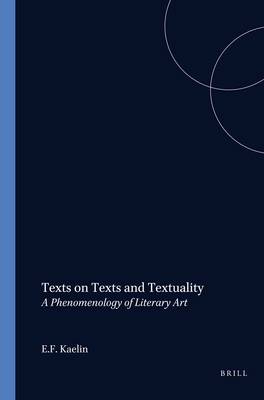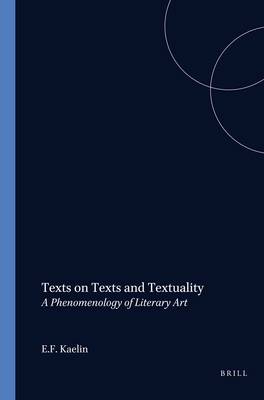
- Afhalen na 1 uur in een winkel met voorraad
- Gratis thuislevering in België vanaf € 30
- Ruim aanbod met 7 miljoen producten
- Afhalen na 1 uur in een winkel met voorraad
- Gratis thuislevering in België vanaf € 30
- Ruim aanbod met 7 miljoen producten
Zoeken
€ 125,45
+ 250 punten
Omschrijving
Texts on Texts and Textuality argues the case for an American phenomenology as applied to works of literary artworks. The argument is made by a surrounding frame (the Preface and the Afterword) that encloses ten chapters. The chapters are divided into two parts: the phenomenological theory and practical criticism. In making his case, Kaelin traces the development in the American academic tradition from the American New Criticism through structuralism to the French nouvelle critique. He calls his theory phenomenological structuralism, and shows its derivation from American pragmatism (contextualism) to an unabashed phenomenology through the criticisms of Roman Ingarden, Martin Heidegger, and Paul Ricoeur. The structuralism derives from the work of Ferdinand de Saussure, as incorporated into the philosophical linguistics of Maurice Merleau-Ponty. Part II contains five chapters, each concerned with either direct application of the theory in acts of criticism, or in the metacriticism of accepted critical theories, such as the Aristotelians of early dramatic critics (Chapter 6), or of applied procedures in recent academic critical circles (Chapter 10). The argument is concluded in the author's Afterword, where pedagogical issues are introduced to suggest the future applicability of the theory. A glossary of technical and new terms is added, and a double index - of names and a subject matter - is included to map out the author's own interpretation of his bibliographic references.
Specificaties
Betrokkenen
- Auteur(s):
- Uitgeverij:
Inhoud
- Aantal bladzijden:
- 252
- Taal:
- Engels
- Reeks:
- Reeksnummer:
- nr. 79
Eigenschappen
- Productcode (EAN):
- 9789042006652
- Verschijningsdatum:
- 1/01/1999
- Uitvoering:
- Paperback
- Formaat:
- Trade paperback (VS)
- Afmetingen:
- 150 mm x 220 mm
- Gewicht:
- 453 g

Alleen bij Standaard Boekhandel
+ 250 punten op je klantenkaart van Standaard Boekhandel
Beoordelingen
We publiceren alleen reviews die voldoen aan de voorwaarden voor reviews. Bekijk onze voorwaarden voor reviews.











